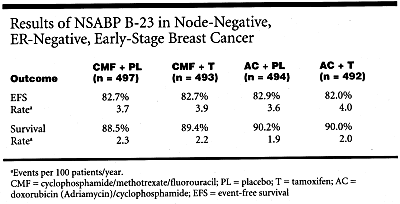AC Comparable to CMF in ER-Negative, Node-Negative Early-Stage Breast Cancer
PITTSBURGH-Four cycles of doxorubicin (Adriamycin) and cyclophosphamide (AC) over 63 days are as effective as six cycles of cyclophosphamide, methotrexate, and fluorouracil (CMF) over 6 months in node-negative, early- stage breast cancer, Bernard Fisher, MD, reported at the ASCO annual meeting.
PITTSBURGHFour cycles of doxorubicin (Adriamycin) and cyclophosphamide (AC) over 63 days are as effective as six cycles of cyclophosphamide, methotrexate, and fluorouracil (CMF) over 6 months in node-negative, early- stage breast cancer, Bernard Fisher, MD, reported at the ASCO annual meeting.
Dr. Fisher presented data from National Surgical Adjuvant Breast and Bowel Project (NSABP) protocol B-23. Those data also showed that tamoxifen (Nolvadex) offered no additional benefit to these patients, all of whom had estrogen-receptor (ER)-negative tumors.
One objective of the study was to determine conclusively whether node-negative, ER-negative women should get tamoxifen, Dr. Fisher explained. There was no benefit from tamoxifen for ER-negative, node-negative patients, he reported.
Dr. Fisher said there was no difference in outcomes with CMF vs AC. So far, NSABP studies have shown that premenopausal, postmenopausal, node-negative, node-positive, ER-negative, and ER-positive women are all candidates for AC. There has been a swing toward using AC, and these findings should accelerate that trend.
The investigators randomized 1,003 women to AC and 1,005 to CMF. Dr. Fisher noted that it was gratifying to see that more patients with early-stage disease, particularly those with small tumors, had undergone lumpectomy rather than mastectomy. Dr. Fisher was instrumental in the development of breast-conserving surgery for early-stage breast cancer.
Patients in B-23 were randomized to four cycles of AC at standard doses given over 63 days with placebo or with tamoxifen, or to 6 cycles of CMF at standard doses given over 6 months with placebo or with tamoxifen. The average time on study was 65 months (range, 13 to 105). Study endpoints were event-free survival (EFS), relapse-free survival (RFS), and overall survival (OS). These and average annual event and mortality rates were presented through 5 years of follow-up.
Dr. Fisher reported that no significant differences in outcomes were noted among the four treatment arms (see Table). There was no disadvantage or advantage to the use of tamoxifen in these patients. There was no difference in outcomes with CMF or AC, and tamoxifen provided no advantage over chemotherapy alone. There is no justification for the administration of tamoxifen to any patient with ER-negative, node-negative, early breast cancer.

Earlier data from a preliminary subset analysis of a Southwest Oncology Group (SWOG) study actually found a detrimental effect of tamoxifen added to chemotherapy in premenopausal, ER-negative, progesterone-receptor-negative patients with early-stage breast cancer, noted discussant James N. Ingle, MD, of the Mayo Clinic, Rochester, Minnesota. The event-free survival in those patients was 88% with chemotherapy vs 82% with chemotherapy plus tamoxifen (P = 0.05), Dr. Ingle said.
An Italian trial also found more deaths in patients treated with tamoxifen alone than with tamoxifen followed by aminoglutethimide, mostly due to cardiovascular causes, Dr. Ingle said. In that trial, overall survival was superior in patients switched from tamoxifen to aminoglutethimide. He said that third-generation aromatase inhibitors are likely to be more effective and less toxic than aminoglutethimide.
The NSABP study reported by Dr. Fisher failed to demonstrate that the use of tamoxifen with chemotherapy was associated with a poorer outcome than when either was administered alone.